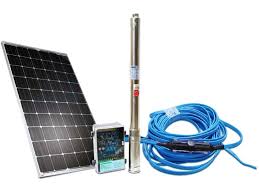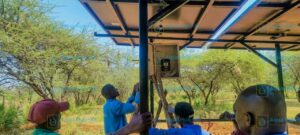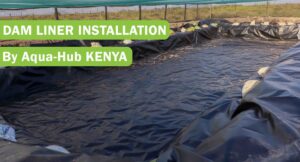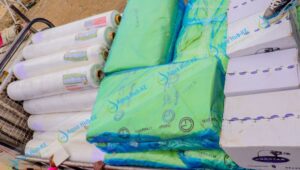Solar irrigation systems in Kenya reduces the cost of irrigation by enabling precision watering without need of fuel consuming water pumps. Aqua Hub Kenya supplies quality solar irrigation kits including solar pumps and drip irrigation kits. With our professional installation our solar pumps supply water to be distributed by drip irrigation ensuring sustainable production.
Solar Irrigation in Kenya
Solar-powered drip irrigation systems in Kenya works through integration of solar systems and drip irrigation kits.
Solar pump System Components & Functions

The essential solar devices include solar Photovoltaic modules, solar pumps and inverters. The solar PV modules trap solar energy from the sun and is transferred to the inverter through electric cables. Solar inverters convert the direct current (sun power) to Alternating Current (AC) to avoid damaging the pump. The requirement for solar inverters depends on the type of solar pump. Some solar pumps use direct current and thus inverter is not required.
Drip Irrigation System
Drip irrigation kits use a connection of HDPE pipes, fittings, and driplines to water plants in a precise and steady water-saving manner.
Combining the technology of solar energy systems with drip irrigation kits creates a sustainable, economical and environmentally friendly solution.
The electricity generated by the solar panels powers a pump that draws water from a source (such as a borehole, well, river, or tank) and pushes it through the drip irrigation network to the crops.
Cost of Solar Irrigation Systems in Kenya
Solar Irrigation systems in Kenya are KES 99,000 minimum to KES 210,000 on maximum for a 1 acre farm size.
Call 0790719020
Why Solar-Powered Drip Kits are Vital for Irrigation Farming
Implementation of solar-powered drip irrigation systems solves the various challenges affecting irrigation farming in Kenya. They include.
Reduced Operational Costs: solar powered drip kits eliminate reliance on electric or fuel costs thus saving on entire irrigation cost.
Lower Maintenance needs: Solar panels, solar pumps and drip kits require less maintenance thus low repair costs
Water Efficiency: Drip irrigation delivers water directly to the plant roots, minimizing water loss through evaporation from the soil surface and runoff.
Water Saving: Studies have shown that drip irrigation can reduce water usage by up to 60% compared to traditional flood irrigation methods.
Uniform irrigation: Drip irrigation maintains consistent soil moisture in the root zone, which is essential for healthy plant growth and nutrient uptake. This leads to more uniform and higher yields.
Reduced Weed Growth: By delivering water directly to the plant roots, the soil surface between rows remains relatively dry, inhibiting weed germination and growth. This reduces the need for manual weeding or herbicides, saving time and money.
Minimized Disease and Pests: Dry foliage and controlled watering reduce the incidence of fungal diseases and create a less favorable environment for certain pests.
Improved Crop Yield and Quality: Consistent water supply leads to more uniform fruit and vegetable size, better yield, and improved quality, potentially fetching higher prices.
Advantages of Solar-powered Drip Irrigation Systems
- Environmentally Sustainable: Solar power is clean, renewable and does not pollute the environment.
- Conserves water drip irrigation kits use water efficiently and thus helps conserve it.
- Reduces Soil Erosion: Controlled water application minimizes soil erosion and nutrient degradation.
- Lowers Carbon emission: solar irrigation contributes to a lower carbon footprint by eliminating use of fuel pumps.
- Increases Income: Higher yields and better-quality produce lead to high income for farmers
- Reduce Labor Needs and Cost: drip systems reduce the manual labor required for irrigation, saving on time and cost.
- Suitable for a wide range of Farm Sizes: Solar drip kits are available in a range of sizes and types that work in both small- and large-scale farms.
- Remote Use: Solar systems are ideal for remote rural areas where electricity access is limited.
Key Considerations When Choosing a Solar-Powered Drip Irrigation Kit
Water Source: analyze the quality, salinity, sediments and volume of water to consider which filters and pipes to use.
Pumping Head Requirements: Pump Head, suction height and pressure required for proper function of the system should be considered. This will influence the pump selection.
Size of farm: Measure the farm to determine the required length of pipes and rolls of drip lines.
Topography: Consider the terrain of the farm, as this can affect water flow and pressure distribution. Pressure regulators may be required in uneven terrain.
Crop Type: Different crops have different water requirements and spacing, which influence the emitter spacing and flow rate.
Solar Pump Power Consumption: The size and number of solar panels needed will depend on the pump’s power requirements.
Pump Type and Size: Select a pump that matches the water source depth, flow rate requirements, and the pressure needed for the drip system. Submersible pumps are commonly used for boreholes and wells, while surface pumps are suitable for tanks and open water sources.
Battery Storage (Optional): Batteries can store excess energy generated during the day, allowing for irrigation during cloudy periods or at night. Consider battery capacity based on the desired autonomy.
Solar Charge Controller: This device regulates the flow of electricity from the solar panels to the batteries and prevents overcharging and deep discharging.
Inverter (for AC Pumps): If an AC pump is used, an inverter is needed to convert the DC electricity from the solar panels or batteries to AC.
Initial Investment Costs: Solar-powered drip irrigation systems typically have a higher upfront cost compared to traditional methods.
Components of Drip Irrigation System
- Mainline and Sub-mains: These are the primary pipes that carry water from the pump to the field. Choose appropriate diameters based on flow rate and pressure requirements.
- Lateral Lines: These smaller pipes branch off from the sub-mains and run along the plant rows, containing the drip emitters.
- Emitters: These are the devices that release water slowly and directly to the plant roots. Select emitters with appropriate flow rates based on crop needs and soil type.
- Fittings and Connectors: Ensure high-quality fittings and connectors to prevent leaks and ensure a reliable system.
- Filtration System: Install appropriate filters (e.g., screen filters, disc filters) to remove sediment and debris that could clog the emitters.
- Pressure Regulators: These devices maintain consistent pressure throughout the drip system, especially on sloping land.
Design and Installation of Drip Irrigation System
Consult professional irrigation experts such as Aqua Hub LTD to design an irrigation system tailored to your farm needs. We design a durable and effective solar irrigation system that will save you money and ensure high yields.
Choosing A Solar Irrigation System Supplier
Choose suppliers with a proven track record and experience in providing solar irrigation solutions in Kenya.
Inquire about warranty terms, availability of spare parts, and after-sales support, including technical assistance and maintenance services.
Opting for a local supplier can ensure easier access to support and maintenance.
Impact of Solar-powered Drip Irrigation Kits in Kenya
By harnessing the power of the sun and the efficiency of drip irrigation, Kenyan farmers can:
- Achieve greater food security at the household and national levels.
- Improve their economic well-being and create more prosperous rural communities.
- Contribute to environmental conservation by using water and energy more efficiently.
- Adapt to the challenges of climate change and build more resilient farming systems.





